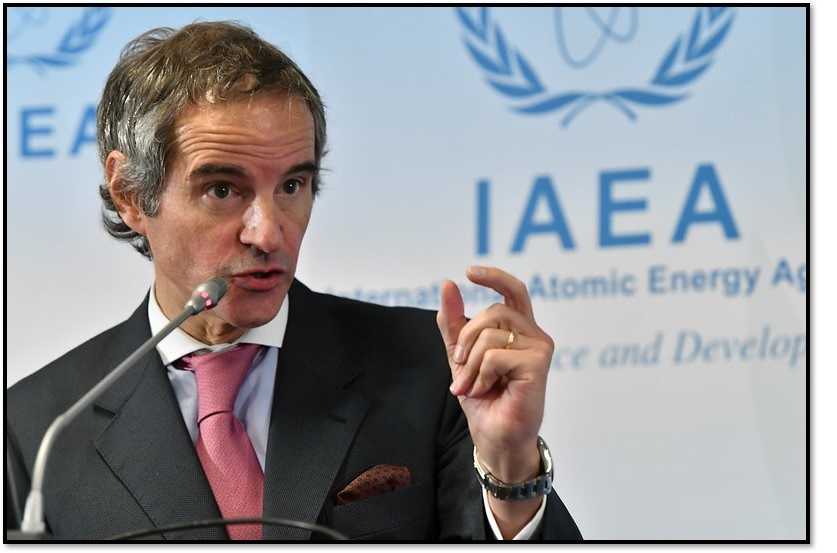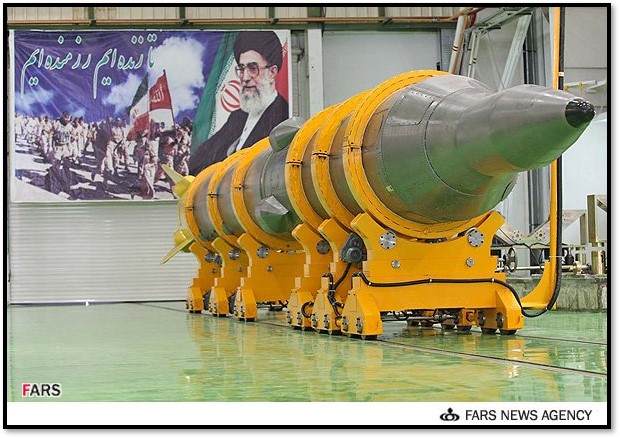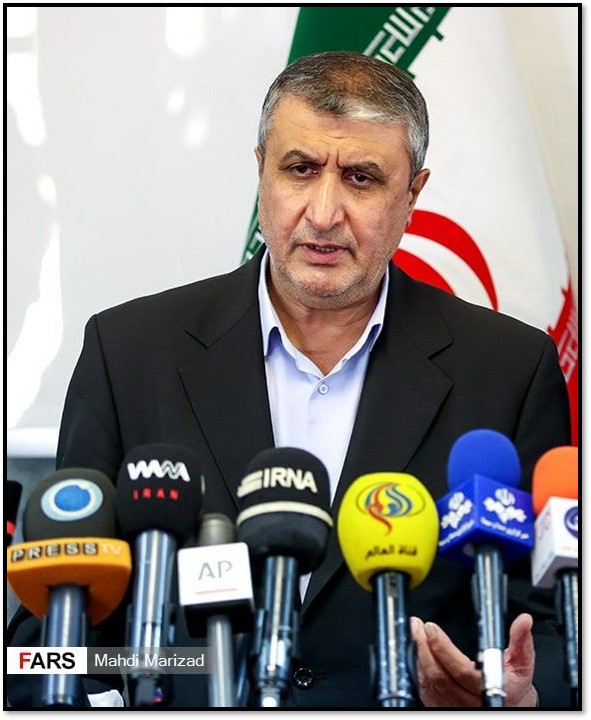Iran has stockpiled more than 18 times the amount of enriched uranium allowed under the 2015 nuclear deal, an unprecedented advance, according to a leaked report by the U.N. nuclear watchdog. The growing stockpile means that Iran could amass sufficient fuel for a single nuclear bomb in a few weeks, although experts claim that the so-called “breakout time” has decreased to a mere 10 days—or less. “This idea of crossing the line, it’s going to happen,” Rafael Grossi, director general of the International Atomic Energy Agency (IAEA), told reporters on June 6. “Having a significant quantity [of highly enriched uranium] does not mean having a bomb,” he said. “Iran can stop, through negotiations, or they themselves can decide to slow down.”

Other steps – beyond producing enough enriched uranium to fuel a bomb – are required to assemble a bomb and marry it to a delivery system, such as a ballistic missile. Iran’s accelerated program means that it could test a nuclear explosive or deploy a crude nuclear weapon within six months and deploy nuclear weapons on ballistic missiles in a year or two, David Albright and Sarah Burkhard wrote for the Institute for Science and International Security (ISIS).
The Arms Control Association (ACA) called the report troubling. Weaponization would still take one to two years, “but that process would be more difficult to detect and disrupt once Iran moved the weapons-grade uranium from its declared enrichment facilities,” wrote Kelsey Davenport, an ACA expert on nuclear weapons. “This drop in breakout significantly increases the proliferation risk posed by Iran’s nuclear program and underscores the urgent need to reimpose limits on Tehran’s nuclear activities, reduce its stockpiles of enriched uranium, and roll back its enrichment capacity.”
Related Material: Problems for IAEA Monitoring in Iran
Iran has long and repeatedly insisted that it does not seek a nuclear weapon, although the IAEA and U.S. intelligence reported that Tehran had a nascent weapons program that it abandoned in 2003. In late 2021, both U.S. and Israeli intelligence agencies reported that the Islamic Republic had not yet made the pivotal political decision to produce the bomb—and incur the possible consequences.
The 2015 nuclear deal, known as the Joint Comprehensive Plan of Action (JCPOA), limited enrichment so that the breakout time would be more than a year. But President Donald Trump abandoned the deal in May 2018; 14 months later, Iran began breaching its obligations in ways that incrementally shortened the breakout time. By May 2022, Iran had amassed 3,809 kilograms (or 8,398 pounds) of enriched uranium—including 43 kilograms (or 95 pounds) of uranium enriched to 60 percent purity. The remainder is enriched from as little as 2 percent purity up to 20 percent. A nuclear weapon requires 90 percent purity. The JCPOA had originally capped Iran’s enrichment to 3.67 percent purity.

After enriching uranium to 90 percent, Iran would need to convert the uranium into a metal that is the explosive core of a bomb. Iran began producing small quantities of uranium metal in July 2021, but then paused production. Iran would also then need to do two things: encase the metal with an outer layer of conventional explosives, then insert it in a warhead small enough to mount on a ballistic missile. Both are significant engineering challenges. Iran already has ballistic missiles that could theoretically carry a nuclear warhead. It is the only country to develop missiles with a range of 2,000 km (1,200 miles) before developing a nuclear weapon.
In April 2021, the Biden Administration launched new diplomacy, alongside five other world powers, to restore full compliance by both the United States and Iran. Most technical issues—Iran’s actions to limit its program and U.S. steps to lift sanctions—were resolved over a year of diplomacy in Vienna. But the talks stalled in March 2022. The biggest hurdle was a dispute between Washington and Tehran over the status of the Islamic Revolutionary Guard Corps (IRGC) as a terrorist group. Tehran demanded that Washington remove the IRGC from the State Department’s list of Foreign Terrorist Organizations.
IAEA Probe into Past Program
In a separate report on Iran’s safeguards agreement, the IAEA said that Tehran failed to explain past covert activities, including traces of uranium at undeclared sites. Three sites have been under investigation since 2019. The activities in question took place before 2003, when Iran halted its nuclear weapons program.

Iran rejected the IAEA report and charged that Israel influenced the findings. “This is not a fair nor balanced report, and it seems that pressure from the Zionists and other actors has diverted the path of technical reports to the political field - and we expect this trend to be corrected,” Foreign Ministry spokesperson Saeed Khatibzadeh said on May 31. Foreign Minister Hossein Amir-Abdollahian warned Western powers not to act against Iran at the IAEA board meeting in early June. “Those who push for anti-Iran resolution at IAEA will be responsible for all the consequences,” he tweeted on June 5.
Mohammad Eslami, the head of the Atomic Energy Organization of Iran, alleged that the IAEA report was based on “fake documents and accounts.” The agency was infiltrated by Iran’s enemies, he claimed in an interview with Al Jazeera on June 6. “How is it possible that confidential reports of an international organization are published in the media even before the official recipients read them?”
Related Material: Iran and the IAEA
But the IAEA countered that Iran had “not provided explanations that are technically credible” about three undeclared locations in Iran. The U.N. watchdog agency cannot confirm that Iran’s nuclear program is exclusively peaceful without further clarification, Grossi told the IAEA board on June 6. “The agency remains ready to re-engage without delay with Iran to resolve these matters.”
On June 7, the United States, Britain, Germany, and France submitted a draft resolution to the IAEA board formally rebuking Iran. The 35-nation board calls on Iran “to act on an urgent basis to fulfil its legal obligations and, without delay, take up the (IAEA) director general’s offer of further engagement to clarify and resolve all outstanding safeguards issues.” The board was due to vote on the resolution by June 10. The following are excerpts from reports from arms control groups analyzing the status of Iran's nuclear program and the impact of its breaches of the 2015 nuclear deal.
Arms Control Association
IAEA Reports Signal Escalating Nuclear Crisis With Iran
Kelsey Davenport
“According to the IAEA’s May 30 report on Iran’s current nuclear program, Tehran has stockpiled enough material enriched to 60 percent uranium-235 that could, if enriched to weapons-grade material, give it enough uranium for one bomb (25 kg) in under 10 days.
“While the 10-day ‘breakout’ is a worse-case scenario estimate, the timeframe is dangerously close to the point where Iran could breakout between regular IAEA inspections. Weaponization would still take 1-2 years, but that process would be more difficult to detect and disrupt once Iran moved the weapons-grade uranium from its declared enrichment facilities. Iran could also use the 43 kilograms of 60 percent enriched uranium to fashion a bomb, although such a device would be bulky and inconsistent with the weapons design Iran pursued during its pre-2003 organized weapons program. Growth in the stockpile of 20 percent enriched uranium gas—now at 238 kilograms—and Iran’s continued use of more advanced centrifuge machines would give Tehran the technical capacity to produce enough weapons-grade material for an additional bomb in another four weeks.
“This drop in breakout significantly increases the proliferation risk posed by Iran’s nuclear program and underscores the urgent need to reimpose limits on Tehran’s nuclear activities, reduce its stockpiles of enriched uranium, and roll back its enrichment capacity. The quickest route to decreasing breakout and restoring more intrusive monitoring is by closing the deal to restore full compliance with the JCPOA.
“According to May 25 testimony from U.S. Special Envoy for Iran Robert Malley, restoring the JCPOA would push the breakout back up to about 6 months. This would give the international community time to respond if Tehran were to make a move toward weaponization in the future.”
“The IAEA’s second report, which details the agency’s investigation into past illicit nuclear activities, further highlights the imperative of restoring the JCPOA. This report concludes that Iran conducted uranium metal activities that should have been declared to the IAEA under Tehran’s legally required safeguards agreement. It also notes that Iran has still not provided technically credible explanations for the presence of processed uranium at three undeclared locations. All these activities date back to the pre-2003 period and do not pose an immediate risk, but Iran’s failure to provide the IAEA with credible information is very concerning and undermines its safeguards obligations—particularly after Iran and the IAEA reached an agreement on March 5 to try and conclude the investigation by the IAEA’s June 6-10 Board of Governors meeting.”
Click here for the full analysis.
Institute for Science and International Security
Iranian Breakout Timeline Now at Zero
David Albright and Sarah Burkhard
“Iran has crossed a new, dangerous threshold; Iran’s breakout timeline is now at zero. It has enough 60 percent enriched uranium or highly enriched uranium (HEU) to be assured it could fashion a nuclear explosive. If Iran wanted to further enrich its 60 percent HEU up to weapon-grade HEU, or 90 percent, it could do so within a few weeks with only a few of its advanced centrifuge cascades.
“In parallel, within a month, it could produce enough weapon-grade uranium for a second nuclear explosive from its existing stock of near 20 percent low enriched uranium. Whether or not Iran enriches its HEU up to 90 percent, it can have enough HEU for two nuclear weapons within one month after starting breakout.
“Within 1.5 months after starting breakout, it could accumulate enough for a third nuclear weapon, using its remaining near 20 percent enriched uranium and some of its 4.5 percent enriched uranium. In 2.75 months after starting breakout, it could have a fourth quantity by further enriching 4.5 percent enriched uranium up to 90 percent. At six months, it could have produced a fifth quantity by further enriching both 4.5 percent enriched uranium and natural uranium. The accumulation for a sixth would take several months longer.
“When Iran ended its crash nuclear weapons program in 2003, its biggest bottleneck was its lack of weapon-grade uranium, needing at least a few more years to accumulate enough weapon-grade uranium for a nuclear weapon. Under intense international pressure, it decided in 2003 to downsize and better camouflage its nuclear weapons effort, while pushing to establish a robust capability to enrich uranium. Today, that decision has borne fruit. While it could only yearn for enough nuclear explosive material for five nuclear weapons in 2003, today it can have enough for those five weapons in six months. With its residual and covert nuclear weaponization capabilities, it could test a nuclear explosive underground or deploy a crude nuclear weapon within several months, certainly within six months, and deploy nuclear weapons on ballistic missiles in a year or two.”
Click here for the full analysis.
The IAEA’s Iran NPT Safeguards Report - May 2022
David Albright, Sarah Burkhard, and Andrea Stricker*
For nearly four years, the IAEA has been investigating the presence of man-made uranium particles at three Iranian sites and, up until its last report, was seeking information about nuclear material and activities at a fourth site. For the first time since the IAEA began its investigation, it uses the actual names of the four sites – Turquz Abad, Varamin, Marivan, and Lavisan-Shian – rather than referring to them as Locations 1-4.
On March 5, 2022, the IAEA and Iran agreed to a timetable for Iran to provide the agency with information and explanations to clarify the IAEA’s discovery of man-made uranium particles at three sites. Under its legal nonproliferation obligations, Iran is bound to explain the activities that led to the use or production of this nuclear material. The IAEA notes that “it has provided Iran with numerous opportunities, in different formats through exchanges and meetings in Vienna and Tehran” to explain the findings, but to no avail.
In a stunning indictment of Iranian non-compliance with the NPT safeguards agreement, the IAEA’s report states, “Iran has not provided explanations that are technically credible in relation to the Agency’s findings at those locations. Nor has Iran informed the Agency of the current location(s) of the nuclear material and/or of the equipment contaminated with nuclear material, that was moved from Turquzabad in 2018. In addition, nuclear activities and nuclear material used therein at Lavisan-Shian were not declared by Iran to the Agency as required under Iran’s Comprehensive Safeguards Agreement.”
The IAEA, in essence, reports that Iran is in breach of the NPT and will remain so until it cooperates: “Until and unless Iran provides technically credible explanations for the presence of uranium particles of anthropogenic origin at Turquzabad, Varamin and ‘Marivan’ and informs the Agency of the current location(s) of the nuclear material and/or of the contaminated equipment, the Agency cannot confirm the correctness and completeness of Iran’s declarations under its Comprehensive Safeguards Agreement.”
Click here for the full analysis.
* Andrea Stricker is a research fellow at the Foundation for the Defense of Democracies
